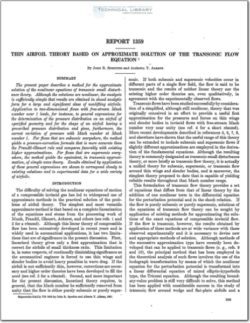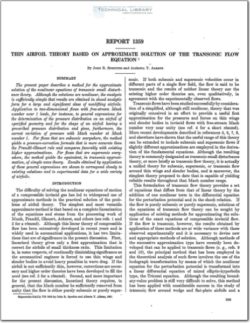NACA-Report-1359

- Version
- 200 Downloads
- 4.24 MB File Size
- 1 File Count
- December 4, 2015 Create Date
- December 4, 2015 Last Updated
National Advisory Committee for Aeronautics, Report - Thin Airfoil Theory Based on Approximate Solution of the Transonic Flow Equation

The present paper describes a method for the approximate
solution of the nonlinear equations of transonic small disturb—
ance theory. Although the solutions are nonlinear, the analysis
is suficiently simple that results are obtained in closed analytic
form for a large and significant class of nonlifting airfoils.
Application to two-dimensional flows with free—stream Mach
number near 1 leads, for instance, to general expressions for
the determination of the pressure distribution on an airfoil of
specified geometry and for the shape of an airfoil having a
prescribed pressure distribution and gives, furthermore, the
correct rariation of pressure unth Mach number at Mach
number 1. For flows that are subsonic everywhere, the method
yields a pressure-correction formula that is more accurate than
the Prandtl-Glauert rule and compares favorably with existing
higher approximations. For flows that are supersonic every—
where, the method yields the equivalent, in transonic approxi-
mation, of simple wave theory. Results obtained by application
of these general expressions are shown to correspond closely to
existing solutions and to experimental data for a wide variety
of airfoils.
The difficulty of solving the nonlinear equations of motion
of a compressible inviscid gas has led to widespread use of
approximate methods in the practical solution of the prob-
lems of airfoil theory. The simplest and most versatile
approximate method is that based on a complete linearization
of the equations and stems from the pioneering work of
Munk, Prandtl, Glauert, Ackeret, and others (see refs. 1 and
2 for a resume). Although this linear theory of compressible
flow has been extensively developed in recent years and is
widely used in aeronautical applications, it has two limita—
tions that are of significance in the present discussion.
First, linearized theory gives only a first approximation that is
correct for ail-foils of small thickness ratio. This limitation
is, in some respects, of continually diminishing significance as
the aeronautical engineer is forced to use thin Wings and
slender bodies to avoid heavy penalties in wave drag. If the
airfoil is not sufiiciently thin, however, corrections are neces-
sary and higher order theories have been developed to fill the
need (see ref. 3 for a résumé). Second, and more important
for the present discussion, linearized theory requires, in
general, that the Mach number be sufficiently removed from
unity that the flow is either purely subsonic or purely super—
sonic. If both subsonic and supersonic velocities occur in
different parts of a single flow field, the flow is said to be
transonic and the results of neither linear theory nor the
existing higher order theories are, even qualitatively, in
agreement with the experimentally observed flows.
| File | Action |
|---|---|
| naca-report-1359.pdf | Download |

Comment On This Post